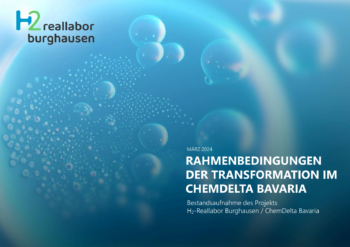Radar for the Holistic Evaluation of Greenhouse Gas Reduction Measures in Industry
Summary
In the assessment of greenhouse gas (GHG) mitigation measures, the focus is usually on techno-economic aspects, even though several other environmental, legal, and socio-political criteria should be considered for a holistic assessment. This publication presents an approach for the holistic assessment of industrial GHG mitigation measures. This includes the Radar for Holistic Assessment of Industrial GHG Mitigation Measures, which is intended to support decision-makers from industry and politics in the assessment of measures.

The added value of the radar (Fig. 1) results from the following three aspects:
- The decision problem is structured, and the relevant evaluation dimensions are shown.
- A traffic light system enables a practical evaluation of the measure(s) per criterion.
- The criteria clustering, the traffic light system, as well as a number of exclusion criteria facilitate the identification of individual obstacle areas.
The assessment results provide the basis for deriving strategies to address barriers. Depending on the stakeholder perspective, these can be both political-regulatory measures and chains of arguments for eliminating internal company resistance.
Starting point
The starting point and inspiration for creating the assessment radar are weaknesses of the most common scientific techno-economic and ecological assessment method for mitigation measures, the so-called GHG mitigation cost curves (MCC) [1]. Using examples and references to further literature, ways to mitigate the key drawbacks of MCC are presented. Subsequently, the measure evaluation by means of MCC is supplemented by further criteria. This invalidates one of the central points of criticism. Finally, an ideal-typical evaluation process is presented, including systemic and practical evaluation criteria.
Which additional criteria are relevant for the evaluation of GHG mitigation measures?
The meta-analyses [2] and [3] show that a large number of multi-criteria analyses (MCAs) already exist for decision-making in technology or measure selection in the energy and sustainability sector. Decision support systems (EUS) specifically tailored to the industrial sector have also been developed in the past. The assessment radar differs from previous analyses as follows:
- The radar represents a decision support tool for stakeholders from industry and politics. As a rule, EUS are defined for one perspective.
- The goal of the radar is to evaluate individual technologies as well as pairs of technologies, not to determine a clear ranking from a list of alternatives.
- It is clear from 1 and 2 that the radar is valid for a range of assessment situations. No criteria weighting is done because the weights are highly dependent on the decision perspective and the defined alternatives [3].
- Instead of criteria weighting, the definition of perspective-independent exclusion criteria is carried out, showing the user severe obstacles to the implementation of measures.
Further information:
- Methodik zur Entwicklung einer Treibhausgasverminderungsstrategie in der Industrie
- Energiewende in der Industrie
- Kohlenstoffdioxid-Einsparpotenziale durch Einsatz strombasierter Grundchemikalien in der stofflichen Nutzung
- Erreichung der Klimaziele – Unterstützungshilfen für die praktische Umsetzung in der Industrie
- Carbon Footprints von Unternehmen – Konkrektisierung mithilfe einer differenzierten Emissionsbilanzierung [Achtung RSF in ÜS]
- SmInd – Modellierung kosteneffizienter Transformationspfade der deutschen Industrie
Sources:
[1] McKinsey & Company, Inc.: Kosten und Potenziale der Vermeidung von Treibhausgasemissionen in Deutschland. New York City: BDI initiativ – Wirtschaft für Klimaschutz, 2009.
[2] Wang, J.-J.; Jing, Y.-Y.; Zhang, C.-F; Zhao, J.-H.: Review on multi-criteria decision analysis aid in sustainable energy decision-making in: Renewable and Sustainable Energy Reviews (Ausgabe 9/2009). Amsterdam: Elsevier Ltd., 2009.
[3] Ibáñez-Forés, V. et al.: A holistic review of applied methodologies for assessing and selecting the optimal technological alternative from a sustainability perspective. In: Journal of Cleaner Production 70 (2014) 259-281. Castellón: Universitat Jaume, 2014.

